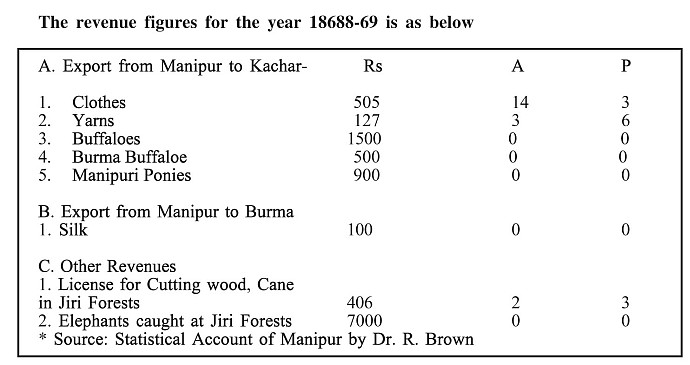Forests of Manipur during Pre-British Period (1826-1891)
- Part 5 -
Akham Bonbirdhwaja Singh *

Revenue : The money revenue was very small, because the Raja being supplied by his people with everything that a Manipuri could want, the being without money revenue was not a cause of much anxiety. So currency money was sparingly used.
But then the transition had to happen, with more intercourse with particularly Myanmar and Cachar, there had to be medium of transactions, which earlier not cared for has become very important. So the importance of money in currency form becomes very important.
The money revenue was very small. The currency mentioned is all in rupee. The major item coming was from annual compensation paid by British Government to Manipur for Kabo Valley.
It was Rs 6370 per annum. The remainder consists of tribute in "sale" from the "sale" of Loees, rent of fisheries, transit duties, and export and import duties.
The total money revenue may be estimated at from twelve to fifteen thousand Rupees. Even with the great disadvantage of an expensive land carriage, the Valley of Manipur is very favorably situated for commercial purposes, but the system of Government is opposed to the development of commerce; and the insecurity of traders in the Burmese territory is so great.
There is no record of any transaction of timber or forest produce, though in the later part, there was sale of tea seed, ivory, rubber and agar (Aquilaria malaccensis Syn agallocha)to traders in Cachar.
During this period, the Dimapur Manipur Cart Road has not yet opened. The DMC Road became operative a little later in late 1890s after the British took over the country. The trade with Assam flourished after that (at one point of time, 1700 carts were registered).
Forest Personnels
There is no mention of any employment in forestry except during King Bhagyachandra titled Urungpurel. He controlled forests and in addition all the brine wells. Dr. Brown mentioned in his account that all the brine wells belong to the King.
Later, as described by T.C. Hodson, the Urungba Loishang was charged with the duty of providing wood, bamboo, creepers and such materials. The Boldeb Seina are overseers of the supply of firewood and Meitansang provides fuel.
In fact, the King's Court does not mention much about forests, but more mention has been made about the hills as in those days hills were synonymous with forests. This is evident from the survey records of Langol Hills and Heingang Hills in 1894 and 1895; this part I shall deal with when I take up forestry during British period.
The detail field level functionaries are not mentioned in pre British period, but during British period, these functionaries are encountered and more fully described.
Concluded..
* Akham Bonbirdhwaja Singh wrote this article for The Sangai Express
This article was posted on September 30, 2013.
* Comments posted by users in this discussion thread and other parts of this site are opinions of the individuals posting them (whose user ID is displayed alongside) and not the views of e-pao.net. We strongly recommend that users exercise responsibility, sensitivity and caution over language while writing your opinions which will be seen and read by other users. Please read a complete Guideline on using comments on this website.







